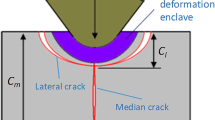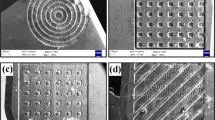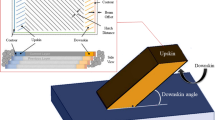Abstract
The shaving process is well known as a precise sheet-metal die-cutting process to achieve a burnish depth through the material thickness. However, in recent years, the requirement of decreases in the rollover on shaved surfaces has become increasingly stringent. To attain this requirement, in the present research, a shaving die was developed and proposed. Based on a stress distribution analysis, a finite element method (FEM) simulation was used as a tool to clarify the cutting mechanism and rollover characteristics by using a conventional shaving die; afterwards, the conventional shaving die was developed, and a new shaving die was proposed to achieve decreases in the rollover. By comparing the cutting principle with that of a conventional shaving die, the concept design of a new shaving die that can achieve decreases in rollover was also clearly illustrated. The decreases in rollover could be successfully achieved by two mechanisms: increases in the compressive stress on the rollover zone and increases in the shaving allowance. The effects of the new shaving die geometries and shaving allowance on rollover were also investigated. To validate the FEM simulation results, laboratory experiments were carried out. The experimental results agreed well with the FEM simulation results in terms of the cut surface characteristics including the rollover, burnish depth, and fracture depth. Therefore, in the present research, it was revealed that the rollover on a shaved surface could be successfully decreased by using the new shaving die application.
Similar content being viewed by others
References
Arslan Y, Uygur I, Jazdzewska A (2015) The effect of cryogenic treatment on microstructure and mechanical response of AISI D3 tool steel punches. J Manuf Sci Eng 137(3):034501
Arslan Y, Özdemir A (2016) Punch structure punch wear and cut profiles of AISI 304 stainless steel sheet blanks manufactured using cryogenically treated AISI D3 tool steel punches. Int J Adv Manuf Technol 87:587–599
Singh G, Gill SS, Dogra M (2017) Techno-economic analysis of blanking punch life improvement by environment friendly cryogenic treatment. J Clean Prod 143:1060–1068
Gustafsson E, Oldenburg M, Jansson A (2016) Experimental study on the effects of clearance and clamping in steel sheet metal shearing. J Mater Process Technol 229:172–180
Gustafsson E, Oldenburg M, Jansson A (2014) Design and validation of a sheet metal shearing experimental procedure. J Mater Process Technol 214:2468–2477
Soares JA, Gipiela ML, Lajarin SF, Marcondes P-VP (2013) Study of the punch–die clearance influence on the sheared edge quality of thick sheets. Int J Adv Manuf Technol 65:451–457
Slavic J, Bolka S, Bratus V, Boltezar M (2014) A novel laboratory blanking apparatus for the experimental identification of blanking parameters. J Mater Process Technol 214:507–513
Thipprakmas S (2010) Application of Taguchi technique to investigation of geometry and position of V-ring indenter in fine-blanking process. Mater Des 31(5):2496–2500
Thipprakmas S (2009) Finite-element analysis of V-ring indenter mechanism in fine-blanking process. Mater Des 30(3):526–531
Hu DC, Chen MH, Ouyang JD, Yin LM (2015) Finite element analysis of the thermal effect in high-speed blanking of thick sheet metal. Int J Adv Manuf Technol 80:1481–1487
Luo C, Chen Z, Kui Z, Yang X, Zhang X (2017) A novel method to significantly decrease the die roll during fine-blanking process with verification by simulation and experiments. J Mater Process Technol 250:254–260
Yiemchaiyaphum S, Jin M, Thipprakmas S (2010) Application of back-up ring in fine-blanking process. Key Eng Mater 443:140–145
Sachnik P, Hoque SE, Volk W (2017) Burr-free cutting edges by notch-shear cutting. J Mater Process Technol 249:229–245
Mao H, Li S, Liu Y, Hua L (2017) An investigation on the microstructure of the fine-blanked sprocket. Int J Adv Manuf Technol 90:3171–3185
Thipprakmas S (2011) Improving wear resistance of sprocket parts using a fine-blanking process. WEAR. 271(9-10):2396–2401
Thipprakmas S, Jin M, Murakawa M (2007) An investigation of material flow analysis in fineblanking process. J Mater Process Technol 192-193:237–242
Thipprakmas S, Jin M, Tomokazu K, Katsuhiro Y, Murakawa M (2008) Prediction of fineblanked surface characteristics using the finite element method (FEM). J Mater Process Technol 198:391–398
Mori K, Maeno T, Fuzisaka S (2012) Punching of ultra-high strength steel sheets using local resistance heating of shearing zone. J Mater Process Technol 212:534–540
Mori K, Abe Y, Kidoma Y, Kadarno P (2013) Slight clearance punching of ultra-high strength steel sheets using punch having small round edge. Int J Mach Tool Manu 65:41–46
Shih HC, Shi MF (2011) An innovative shearing process for AHSS edge stretch ability improvements. ASME J Manuf Sci Eng 133(6):061018
Dong L, Li S, He J, Cui R (2016) Investigation on shearing and local formability of hot-rolled high-strength plates. ASME J Manuf Sci Eng 138(9):091001
Hu XH, Choi KS, Sun X, Golovashchenko SF (2014) Edge fracture prediction of traditional and advanced trimming processes for AA6111-T4 sheets. ASME J Manuf Sci Eng 136(2):021016
Lange K (1985) Handbook of metal forming, vol 24. McGraw-Hill, Inc, New York, pp 1–24.42
Sasada M, Togashi T (2014) Measurement of rollover in double-sided shearing using image processing and influence of clearance. Procedia Eng 81:1139–1144
Sun XL, Zhuang XC, Yang FC, Zhao Z (2018) Reduction of die roll height in duplex gears through a sheet-bulk metal forming method. Adv Manuf:1–10
Liu Y, Cheng T, Hua L, Mao H (2017) Research on the effect of ultrasonic vibration on the roll-over during the fine blanking process. J Mech Sci Technol 31(2):835–843
Liu Y, Tang B, Hua L, Mao H (2018) Investigate of a novel modified die design for fine-blanking process to reduce the die roll size. J Mater Process Technol 260:30–37
Huang X, Xiang H, Zhuang XC (2011) Improvement of die roll quality in compound fine-blanking forming process. Adv Mater Res 337:236–241
Luo C, Chen Z, Zhou K, Yang X, Zhang X (2017) A novel method to significantly decrease the die roll during fine-blanking process with verification by simulation and experiments. J Mater Process Technol 250:254–260
Murakawa M, Suzuki M, Shionome T, Komuro F, Harai A, Matsumoto A, Koga N (2014) Precision piercing and blanking of ultrahigh-strength steel sheets. Procedia Eng 81:1114–1120
Hoffmann H, Hörmann F (2007) Improving the cut edge by counter-shaving. Key Eng Mater 344:217–224
Masahiro S, Yusuke K, Takayuki K (2014) Influence of the punch penetration depth in half punching on the cut edge after shaving. Key Eng Mater 622(632):1081–1086
Sasada M, Katou S (2018) Effect of use of protrusion punch on length of burnished surface in piercing after half punching. Procedia Manu 15:653–659
Hoffmann H, Hörmann F (2007) Clean-sheared and rectangular edges through counter-shaving. Prod Eng Res Devel 1:157–162
Thipprakmas S, Phanitwong W, Chinwithee M, Morkprom T (2010) Reciprocating shaving approach to eliminate crack and burr formations in pressed parts. Key Eng Mater 443:201–206
Thipprakmas S, Phanitwong W (2010) Finite element analysis of shaving direction effects in reciprocating shaving process. Steel Res Int 81:1058–1061
Chung WJ, Hwang KB, Kim JH, Ryu HY (2008) A study on the improvement of the accuracy of a shaving process using a progressive die. Int J Mod Phys B 22:5673–5679
Thipprakmas S, Rojananan S, Paramaputi P (2008) An investigation of step taper-shaped punch in piercing process using finite element method. J Mater Process Technol 197:132–139
Murakawa M, Nakamura K, Shionome T, Komuro F, Muro G, Koga N (2013) Press-shaving characteristics of ultra-high strength steel sheets. Key Eng Mater 554–557:1879–1886
Phanitwong W, Sontamino A, Thipprakmas S (2016) Experimental analysis of the feasibility of shaving process applied for high-strength steel sheets. Adv Mater Sci Eng Article Number:1634840
Yiemchaiyaphum S, Jin M, Thipprakmas S (2010) Die design in fine-piercing process by chamfering cutting edge. Key Eng Mater 443:219–224
Acknowledgements
The authors would like to express their gratitude to Wiriyakorn Phanitwong, Ph.D., Department of Industrial Engineering, Rajamangala University of Technology Rattanakosin, for her advice on this research.
Funding
This research was partially supported by the Higher Education Research Promotion and National Research University Project of Thailand, Office of the Higher Education Commission, under Grant No. 56000519 and Grant No. 57000618.
Author information
Authors and Affiliations
Corresponding author
Additional information
Publisher’s note
Springer Nature remains neutral with regard to jurisdictional claims in published maps and institutional affiliations.
Rights and permissions
About this article
Cite this article
Sontamino, A., Thipprakmas, S. Development of a shaving die design for reducing rollover. Int J Adv Manuf Technol 103, 1831–1845 (2019). https://doi.org/10.1007/s00170-019-03639-9
Received:
Accepted:
Published:
Issue Date:
DOI: https://doi.org/10.1007/s00170-019-03639-9




